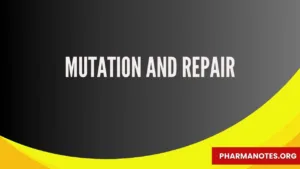Mutation and Repair

Objective
At the end of this lecture, student will be able to
• Explain mutation and repair mechanisms
DNA Mutation and Repair
DNA Damage
Mechanisms for maintaining genetic stability associated with DNA replication in E. Coli
Mechanism frequency Cumulative error
Base pairing ~10-1 – 10-2
DNA polymerase actions (including base selection, 3′->5’proofreading) ~10-5 -10-6
Accessory proteins (e.g. SSBP) ~10-7
Post-replication mismatch correction ~10-10
Spontaneous alterations:
(a) Mismatches: Occurs during DNA synthesis (i.e. replication, repair, or recombination)
(b) Tautomeric shifts
• Nucleotides spontaneously undergo a transient rearrangement of bonding, e.g. a shift from NH2 (amino form) to NH (imino form) or C=O (keto) to C- OH (enol).
• Therefore, if any base in a template strand exists in its rare tautomeric form during DNA replication, misincorporation in the daughter strand can result.
Base Pairing of Imino A-C
(c) Deamination
• Three of the four bases normally present in DNA (cytosine, adenine, and guanine) contain amino group (NH2).
• The loss of the amino group (deamination) can occur spontaneously and result in the conversion of the affected bases to uracil, hypoxanthine, and xanthine, respectively.
(d) Loss of bases
• Depurination & depyrimidination: The loss of purines or pyrimidines from DNA usually occurs at acidic pH;
• This will results in breaking the 3’ phosphodiester bond called b- elimination.
Induced Mutations
(a) Physical agents that damage DNA:
– Ionizing radiation: OH, O2, H2O2, damage base and sugar residues.
– UV radiation: Cyclobutane pyrimidine dimers, Thymidine dimers (T-T) dimer
(b) Chemical agents that damage DNA:
• Alkylating agents: Alkylating agents are electrophilic compounds with affinity for nucleophilic centers in organic macromolecules.
• These include a wide variety of chemicals, many of which are proven or suspected carcinogens (such as nitrous acid, hydroxylamine, and ethylmethane sulfonate, EMS), Adding alkyl group to hydrogen-bonding oxygen of G or T, resulting in G-T mispairing
G-C —> G*T —>A-T
T-A —>T*-G —> CG
(c) Base-analogue Agents
• A base analogue is a substance other than a standard nucleic acid base that can be incorporated into a DNA molecule by the normal process of polymerization.
• Such a substance must be able to pair with the base on the complementary strand being copies, or the 3′->5′ editing function will remove it.
• For example, 5-bromouracil is an analogue of thymine and might cause an A-T to G-C transition mutation.
Base Analogue
(d) Intercalating agents:
• Substances whose dimensions are roughly the same as those of a purine-pyrimidine pair
• In aqueous solutions, these substances form stacked arrays
• Able to stack with a base-pair by insertion between two base-pairs. This may result in frameshift mutation.
Model of intercalating agent-induced mutagenesis
Type of Mutations
I. Point mutation:
A. Base substitution
Change in DNA
Transition: One purine replaced by a different purine; or one pyrimidine replaced by a different pyrimidine
A à G T à C
Transversion: A purine replaced by a pyrimidine or vice versa
A à T C à G
Change in protein
1. Silent mutation: altered codon codes for the same a.a.
2. Neutral mutation: altered codon codes for functional similar a.a.
GAG (Glu) —>GAA (Glu)
3. Missense mutation: altered codon codes for different dissimilar a.a.
GAG—>GAC (Asp)
4. Nonsense mutation: altered codon becsomes a stop codon
GAG —> AAG (Lys)
GAG —> UAG (stop)
B. Frameshift mutation: addition or deletion of one base-pair result in a shift of reading frame and alter amino acid sequence
Metabolite Mutagens
Chemicals that are metabolized to electrophilic reagents: Aflatoxins, benzo[a]pyrene
• A mutagen is a physical or chemical agent that causes mutations to occurs.
• Mutagenesis is the process of producing a mutation.
• Mutant refers to an organism or a gene that is different from the normal or wild type.
Reversion and the Ames test:
Mutants may have second mutation and become wild type again.
Reversion was used as a means of detecting mutagens and carcinogens- the Ames test
DNA Repair Mechanisms
(1) Repair by direct reversal: The simplest mechanism. e.g. UV induced T-T dimer is recognized by photolyase and is cleaved into intact thymine (light dependent). This is called photoactivation
(2) Excision Repair: The most ubiquitous repair mechanism, which can deal with a large variety of structural defects in DNA.
(3) Recombinational repair (Postreplicational repair): Occurs before excision repair has happened or when excision repair cannot fix the problem
(4) The SOS response: The SOS response system is only active in response to some signal such as a blocked of replication fork. In E. Coli, recA and lexA govern the expression of a number of other genes involved in DNA repair. This is an error-prone DNA repair mechanism and result in higher than normal mutagenesis.
SOS DNA Repair
1. DNA damage
2. RecA converted to RecA*
3. RecA* facilitated LexA self-cleavage
4. Increased synthesis of SOS proteins
5. Error prone repair induced
6. DNA damage repaired
7. RecA* returned to RecA
8. LexA no longer self-cleaved
9. LexA repressed SOS genes
10. LexA repress lexA gene expression
Summary
• Mutation can be of endogenous or exogenous origin
• Mismatches: Occurs during DNA synthesis
• Intercalating agents are those substances whose dimensions are roughly the same as those of a purine-pyrimidine pair
• Addition or deletion of one base-pair result in a shift of reading frame and alter amino acid sequence known as frameshift mutation
Also, Visit:
B. Pharma Notes | B. Pharma Notes | Study material Bachelor of Pharmacy pdf














